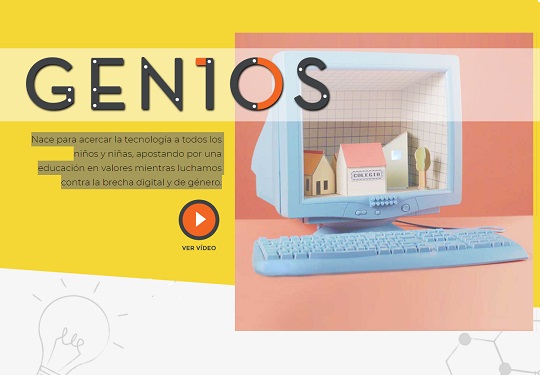
The GEN10S Project aims to bring technology closer to all children and teenagers, committing to an education in values while fighting the digital and gender gap.
The GEN10S Project was created in 2015, by Ayuda en Acción, with the collaboration of Google.org, who set themselves a challenge: bringing the world of science and technology closer to children and teenagers on equal conditions. To this end, they collaborate with a network of educational centres throughout Spain which, in their classrooms, help thousands of students to discover their inner genius.
You can participate in the project through this form.
The objectives are to democratise access to technological education and to promote greater technological and social inclusion, by means of educational innovation, to reduce the gender gap in the technological world and to empower women in scientific and technological vocations, and to raise scientific and technological vocations.
We work for children and teenagers to become active citizens with a rights approach, and to be aware of their responsibility in the face of unfair situations and their transforming power to change reality.
This project promotes Education for Global Citizenship processes. Specifically, they work on education in values under the umbrella of the following Sustainable Development Objectives: Quality Education, Gender Equality and Climate Action.
Programming
Programming for primary and secondary students in the participating centres is implemented through four-monthly activities which are taught during school hours in the network of schools and high schools participating in the programme.
They are organised in groups of two or three and they work on challenges proposed by the training person according to the GEN10S educational materials. The GEN10S sessions are led by a technologist instructor from Ayuda en Acción, who is accompanied by the class tutor. This way, teachers can attend and learn the formative methodology of the project.
All the instructors pass a demanding selection process which has formed a highly qualified group of work. Likewise, at the end of the course, there is an evaluation of the project in which all the people involved participate. The GEN10S methodology, designed by organisations specialised in technologist training in collaboration with the teaching team of Ayuda en Acción, is based on 3 dimensions:
- Foundations of programming
- Project work with a 'learning by doing' approach
- Cooperative work between teams
It is important to reinforce digital education from an early age. To this end, programming becomes a very useful tool that helps children to develop as computational thinkers, promotes values such as teamwork, creates new, more creative and more enterprising structures of thought, and allows the development of the imagination in a technological context.
Primary levels make use of Scratch, a software that allows to create eye-catching programs in a very simple way, which is very useful for children of this age. In secondary education, teenagers’ skills –such as computational thought– are developed through computer programming and teamwork. Technology is also used to transmit values related to cohabitation, diversity, environment, cooperation, etc.
Language learning and programming tools are incorporated to set the basis of web development in creative, artistic and visual environments. App inventor, created by Google and aimed at the creation of applications for Android in mobile devices, is also used.












